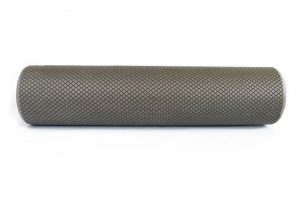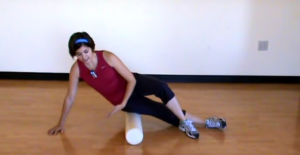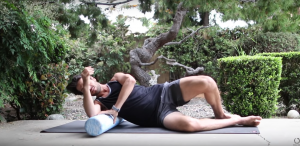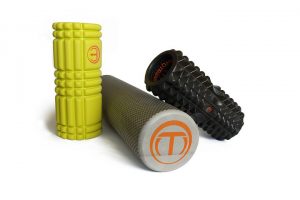 Are you one of the many who have written off foam rolling as just another exercise fad? It’s understandable. You look at that rigid foam cylinder and wonder how rolling it under various parts of your body could possibly do anything. That’s the problem with judging books by their covers. It’s the same way with the TargitFit Trainer. You can’t even begin to imagine what an incredible workout you’ll get on it. You have to jump in and give it a try. But, I digress…
Are you one of the many who have written off foam rolling as just another exercise fad? It’s understandable. You look at that rigid foam cylinder and wonder how rolling it under various parts of your body could possibly do anything. That’s the problem with judging books by their covers. It’s the same way with the TargitFit Trainer. You can’t even begin to imagine what an incredible workout you’ll get on it. You have to jump in and give it a try. But, I digress…
If you suffer from tight muscles, impeded range of motion, neck, back, or leg pain, or trigger-point sensitivity otherwise known as knots in your muscles, give foam roller exercises a chance. We’ll quote some of the research and benefits below, but personal experience reveals that you’ll feel so much better after as little as a 5-minute session, you won’t hesitate to add a foam roller to your regular routine every time you exercise.
How Does it Work?
If you’ve never had a really good deep-tissue massage, then you might not understand what foam roller exercises can do for you. However, if you’ve experienced the bliss of a skilled massage therapist working the knots out of your muscles—and aches and pains along with them—then you’ll get the picture. It’s the same type of myofascial release, but it’s DIY.

Image via SparkPeople/YouTube
Although the roller is made of foam, the material has very little give. As you roll it under your body, gravity works with your body weight and the ultra-firm roller to essentially massage away tension, relax your muscles, and alleviate joint stress and muscle tissue soreness. In fact, the benefits of foam rolling also include:
- breaking up scar tissue and lengthening muscles
- decreased muscle tension
- correcting imbalances in muscles
- increasing range of motion
- improving circulation for better neuromuscular efficiency
What’s more, studies have also found foam rolling to be useful for aiding recovery after intense exercise as well as increasing muscle activation and even vertical jump height (!).
“Yes, but how does it work?” you may be asking. Just like with massage, foam rolling gets your blood flowing, bringing more oxygen to the muscle tissue to help it repair and work properly. Also, according to the National Academy of Sports Medicine, the pressure deactivates undue muscle spindle activity that causes muscles to tense, shorten, knot up, and become imbalanced.
Real Results

Image via Yoga Dose/YouTube
If you’re still skeptical and wonder how well foam rolling could possibly work, would you believe a personal testimony? After chiropractic adjustments and wearing a soft collar failed to provide lasting relief from pain in my neck, shoulders, and upper back, I found a YouTube video demonstrating a couple of foam roller exercises for those specific areas and gave them a try. OMG doesn’t even describe how I felt after spending less than 10 minutes doing the exercises. It alleviated my pain for the rest of the day and increased the range of motion in my arms and neck—I could finally turn my head to look to the side, lift my arms above shoulder height, and my fingers aren’t numb or tingling! The level of excitement over those seemingly small accomplishments should tell you what kind of pain and restrictions I’d been living with.
Full disclosure, the pain and restricted mobility came back the next day, but not as severely. So, 2 days after first trying foam rolling, I went through the exercises again and then performed a 20-minute yoga routine for stress-relief. It was the first time I’d been able to exercise in a week. The result was another pain-free afternoon and evening and I still feel great. The ultimate result? I’ll be starting all my workouts—yoga, resistance training, and even cardio—with foam rolling as part of my warm-up routine. Also, I will still visit the chiropractor and massage therapist as needed but, if these early indications end up being long-term benefits, that “as needed” basis will probably be less frequent than it has been over the last few years.
Miraculous Foam Roller Exercises You Should be Doing Right Now
 By now, you get that I consider foam roller results to be magical. When you live with restricted mobility and a lot of pain, and something can take that away immediately, how else can you describe it? Still, before we turn you lose with a handful of foam roller exercises, there are a few things you should know. First, there are different sizes of foam rollers with different diameters and lengths. Smaller rollers are easier to transport and store and are good for targeting specific body parts. Larger rollers are still pretty useful for most areas of the body and are especially good for larger muscle groups like your back or leg muscles.
By now, you get that I consider foam roller results to be magical. When you live with restricted mobility and a lot of pain, and something can take that away immediately, how else can you describe it? Still, before we turn you lose with a handful of foam roller exercises, there are a few things you should know. First, there are different sizes of foam rollers with different diameters and lengths. Smaller rollers are easier to transport and store and are good for targeting specific body parts. Larger rollers are still pretty useful for most areas of the body and are especially good for larger muscle groups like your back or leg muscles.

Super-firm rollers or ones with ridges might be a little hard-core if you’re new to foam rolling. Opt for a softer, smooth roller at first to avoid discomfort.
You can get foam rollers with different firmness levels, too. Women’s Health warns that firmer rollers provide deeper pressure, even to the point of pain, if you’re not careful. I’ll admit: my first experience did include a little pain. My roller is quite firm and there are two smooth sides alternating with two sections of grooved ridges. But I adjusted, limiting the amount of pressure I allowed my body to create and using the smooth sides when I was doing the exercises on my ribs and lat muscles. Approaching it mindfully, my foam roller session went from “ouch!” to “hurts so good!”
Up front, you should know that it’s advised not to use foam rollers to apply direct pressure to your spine, including the cervical area that makes up your neck. Also, don’t rush things. Time magazine points out that of all the studies done on foam rolling exercises, the ones that had the best results were those in which participants spent 90 seconds or more on each individual exercise.
The exercises that are most often associated with foam rollers tend to be for the legs such as:
glutes…
…quads…
…hamstrings…
…IT bands…
…and calves.
However, I found exercises that work great on the upper back and shoulders, including the area between the shoulder blades. Here’s that awesome sequence that worked wonders for me:
There are also roller exercises that target the lower back:
And, although you’re not supposed to use rollers directly on your cervical spine, there are ways it can be used to increase mobility and alleviate pain and tension in your neck:
Foam rollers…who knew?
